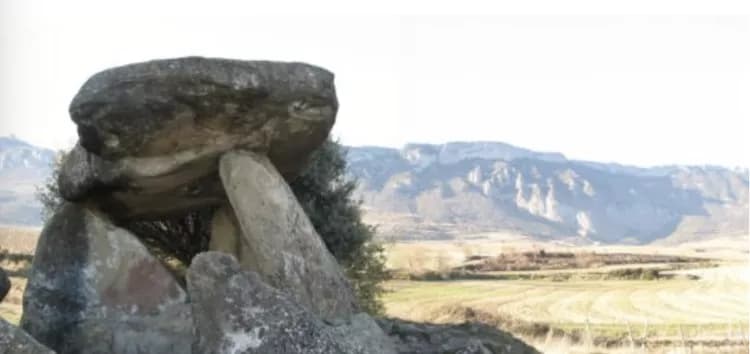
Bones Reveal Social Differences Between The People Buried In Dolmens And Those In Caves
The researcher Teresa Fernández-Crespo, lead author of this study, had in a previous piece of work found demographic differences between the people buried in dolmens and those buried in caves: while male adults predominated in the dolmens, children and women were more common in the caves. This funerary variability is common across the continent of Europe, although "it has hardly ever been investigated systematically," explained the researcher.
Through this study they wanted to go further and "get to know the possible significance of the different funerary practices in a very restricted space-time sequence to see whether there could be a difference in the diet of the individuals buried in megaliths and those in caves." The key is to be found in the diet, which aside from addressing a physiological need, "also constitutes cultural and social behaviour determined by various parameters. That is why we knew that through the eating patterns we could make out something about the social structure and the type of societies that had been buried in these locations," she explained.
The analysis has focussed on remains in the Rioja Alavesa area, which "is an unrivalled region where the caves and dolmens are very close to each other, at an average distance of 10 km. Thanks to the available dating, we have been able to distinguish the late Neolithic and early Chalcolithic moments of the dolmens to be able to compare them with the sequences of the caves corresponding to that same period."
The work involved measuring the stable carbon and nitrogen isotopes in bone collagen. "These isotopes are used to try and reconstruct diet in the past. And the fact is that the composition of human bones is determined by the food consumed by the individual during approximately the last decade of his/her life, because bone tissue is gradually remodelled. That is no surprise because 'we are what we eat'; what happens is that in the end everything we eat is gradually incorporated into our tissue," said Fernández-Crespo.
Different communities or socioeconomic differences?
The results show that the diet of the individuals was based on "plants of the C3 type, such as cereals, because they were already being grown during that period, with a contribution from land-based animals, mainly domesticated ones (goats, sheep, cows). This seems to have been the general diet of both sepulchral types." But, in actual fact, the most important discovery is the significant differences in the carbon isotope values between caves and megaliths.
Two possible interpretations are put forward to explain this difference. "The first would be that this divergence reflects a differentiated use in certain communities that practised different funeral rites and likewise followed different subsistence economies due to the use of different farming areas: in the case of the caves, the slopes of the Cantabria mountain ridge, and in the case of the dolmens, the more open areas of the valley," pointed out the researcher.
With respect to the second option, "the divergences in the carbon isotope values could also have emerged within the same community, where everyone belonged to the same group in which there was economic specialisation. In other words, one sector of the population could, for example, have been more involved in grazing activities on the mountain ridge, and the other in agriculture in the valley, or there might have been socioeconomic differences that were expressed in the preferential access to more fertile areas or to certain foods. Those laid to rest in caves may have enjoyed a lower status and their access to better lands for agriculture may have been more restricted, whereas those buried in megaliths, the building of which required considerable investment in terms of work, may have had access to better lands (more open, more fertile ones, etc.)."
As regards the future, other channels of research are being proposed to find out "which hypothesis we should be opting for." So an analysis of strontium and oxygen isotopes is proposed as this would enable the mobility of these populations to be assessed, "since some authors are suggesting that during the late Neolithic and early Chalcolithic this region was very densely populated possibly as a result of the arrival of a foreign population. So those who are occupying one burial type or another could well be populations that came from outside," pointed out Fernández-Crespo.
Furthermore, research based on the sequential analysis of carbon and nitrogen isotopes on the dentine of teeth has been started. "If the bones are remodelled and only display the sign of the last ten years of life of the individuals, the isotopic sign of carbon and nitrogen of the moment they were formed is recorded in the teeth. This study could reveal whether the differences between the people buried in dolmens and those in caves emerge from birth onwards (two populations that are doing something different) or whether they are acquired over time, which would lead us to think that they are more linked to the status achieved by each individual," explained Teresa Fernández-Crespo.
Materials provided by University of the Basque Country. Note: Content may be edited for style and length.
Disclaimer: DoveMed is not responsible for the accuracy of the adapted version of news releases posted to DoveMed by contributing universities and institutions.
References:
Teresa Fernández-Crespo, Rick J. Schulting. (2017). Living different lives: Early social differentiation identified through linking mortuary and isotopic variability in Late Neolithic/ Early Chalcolithic north-central Spain. PLOS ONE. DOI: 10.1371/journal.pone.0177881
Related Articles
Test Your Knowledge
Asked by users
Related Centers
Related Specialties
Related Physicians
Related Procedures
Related Resources
Join DoveHubs
and connect with fellow professionals

0 Comments
Please log in to post a comment.